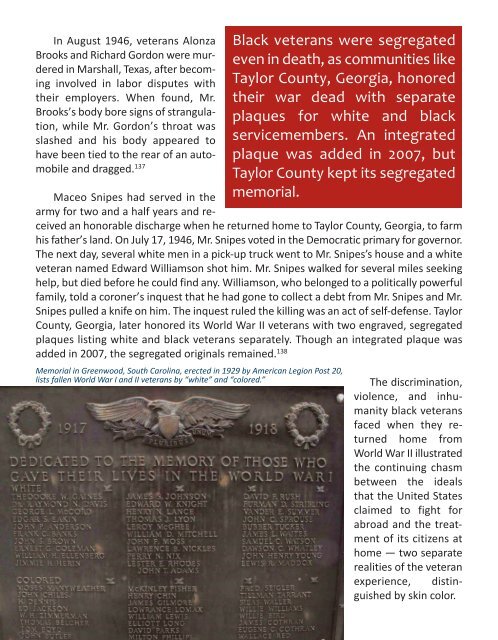Create successful ePaper yourself
Turn your PDF publications into a flip-book with our unique Google optimized e-Paper software.
In August 1946, veterans Alonza<br />
Brooks and Richard Gordon were murdered<br />
<strong>in</strong> Marshall, Texas, after becom<strong>in</strong>g<br />
<strong>in</strong>volved <strong>in</strong> labor disputes with<br />
their employers. When found, Mr.<br />
Brooks’s body bore signs of strangulation,<br />
while Mr. Gordon’s throat was<br />
slashed and his body appeared to<br />
have been tied to the rear of an automobile<br />
and dragged. 137<br />
Maceo Snipes had served <strong>in</strong> the<br />
army for two and a half years and received<br />
an honorable discharge when he returned home to Taylor County, Georgia, to farm<br />
his father’s land. On July 17, 1946, Mr. Snipes voted <strong>in</strong> the Democratic primary for governor.<br />
The next day, several white men <strong>in</strong> a pick-up truck went to Mr. Snipes’s house and a white<br />
veteran named Edward Williamson shot him. Mr. Snipes walked for several miles seek<strong>in</strong>g<br />
help, but died before he could f<strong>in</strong>d any. Williamson, who belonged to a politically powerful<br />
family, told a coroner’s <strong>in</strong>quest that he had gone to collect a debt from Mr. Snipes and Mr.<br />
Snipes pulled a knife on him. The <strong>in</strong>quest ruled the kill<strong>in</strong>g was an act of self-defense. Taylor<br />
County, Georgia, later honored its World War II veterans with two engraved, segregated<br />
plaques list<strong>in</strong>g white and black veterans separately. Though an <strong>in</strong>tegrated plaque was<br />
added <strong>in</strong> 2007, the segregated orig<strong>in</strong>als rema<strong>in</strong>ed. 138<br />
Memorial <strong>in</strong> Greenwood, South Carol<strong>in</strong>a, erected <strong>in</strong> 1929 by <strong>America</strong>n Legion Post 20,<br />
lists fallen World War I and II veterans by “white” and “colored.”<br />
Black veterans were segregated<br />
even <strong>in</strong> death, as communities like<br />
Taylor County, Georgia, honored<br />
their war dead with separate<br />
plaques for white and black<br />
servicemembers. An <strong>in</strong>tegrated<br />
plaque was added <strong>in</strong> 2007, but<br />
Taylor County kept its segregated<br />
memorial.<br />
The discrim<strong>in</strong>ation,<br />
violence, and <strong>in</strong>humanity<br />
black veterans<br />
faced when they returned<br />
home from<br />
World War II illustrated<br />
the cont<strong>in</strong>u<strong>in</strong>g chasm<br />
between the ideals<br />
that the United States<br />
claimed to fight for<br />
abroad and the treatment<br />
of its citizens at<br />
home — two separate<br />
realities of the veteran<br />
experience, dist<strong>in</strong>guished<br />
by sk<strong>in</strong> color.


